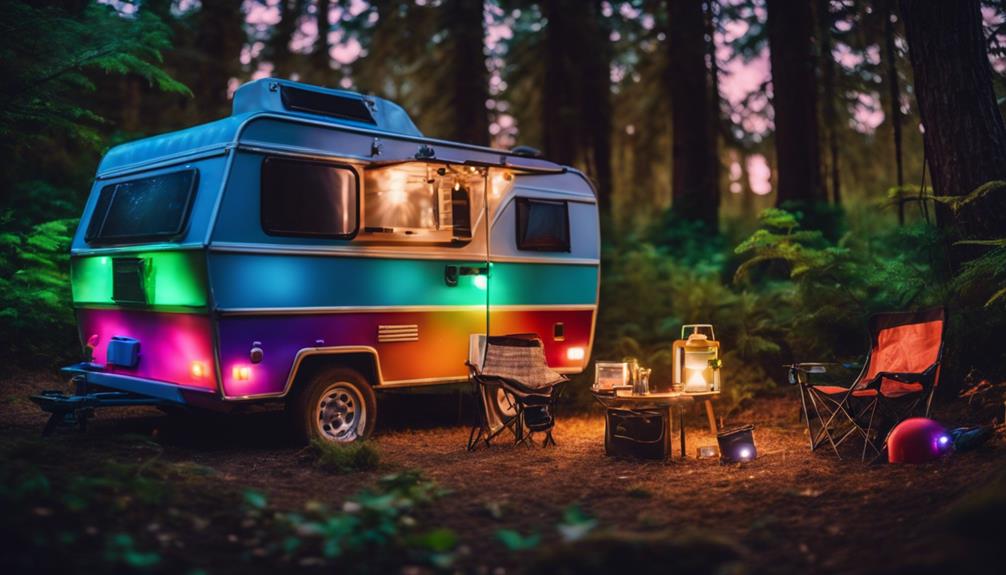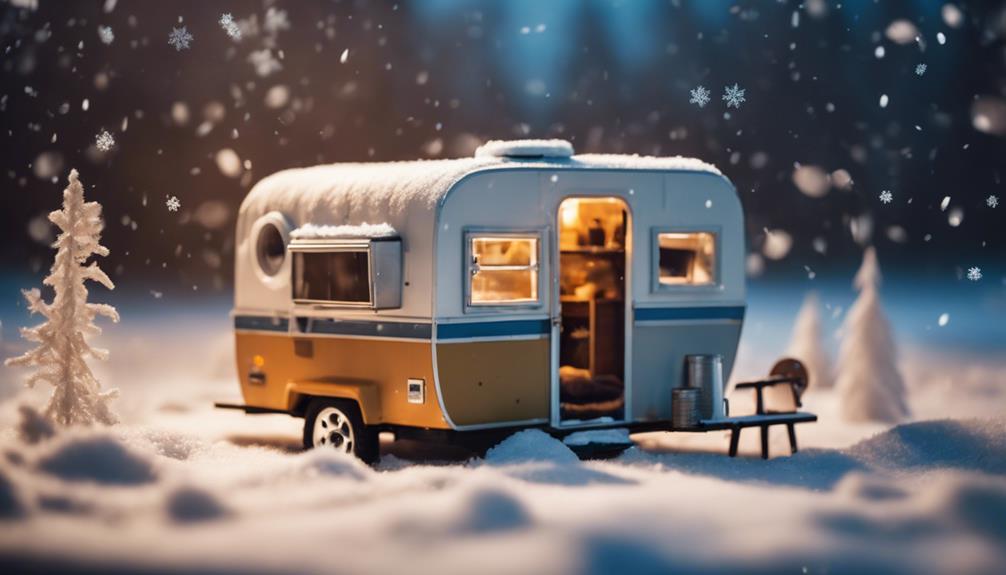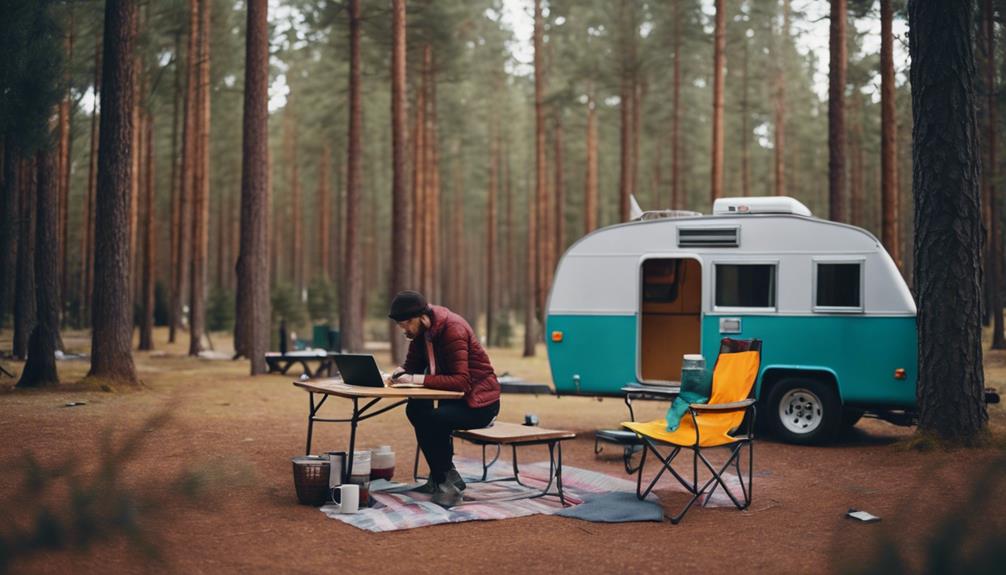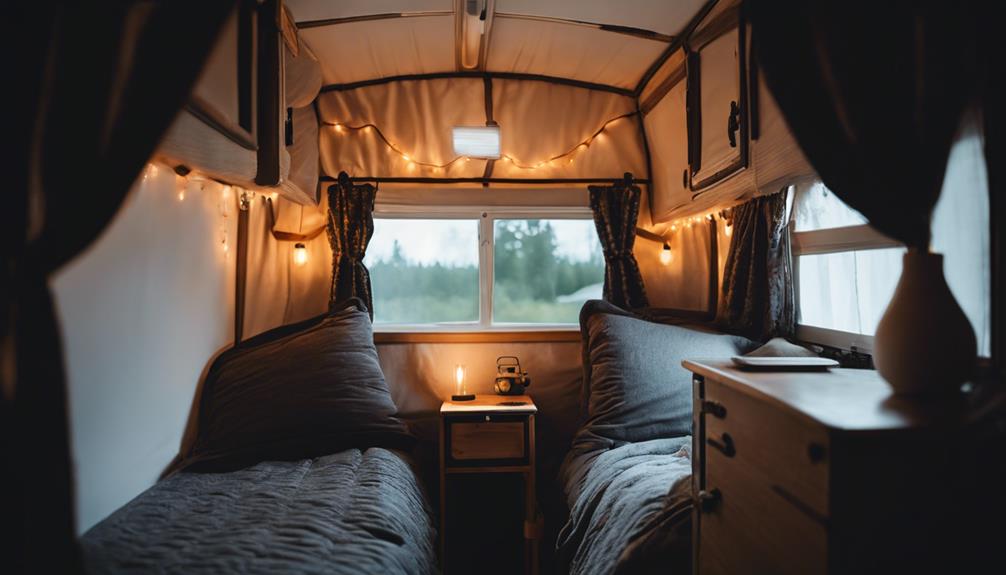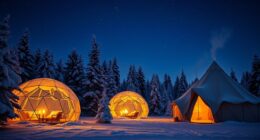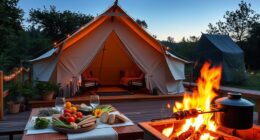To prevent condensation in your pop-up camper, focus on effective ventilation and insulation. Open windows slightly and use roof vents to promote airflow and expel humid air. Consider installing reflective insulation, like Pop-Up Gizmos, to keep the interior warm and reduce condensation. Use small fans to enhance air circulation, drawing in dry air and pushing out moisture. Regularly clean your camper and dry it thoroughly after use, especially in humid conditions. Managing humidity levels is key to a comfortable experience, and you'll discover even more tips to keep your camping space cozy and dry.
Key Takeaways
- Open windows and roof vents to promote airflow and reduce humidity levels inside the camper.
- Use reflective insulation like Pop-Up Gizmos to maintain warmer temperatures and minimize condensation.
- Employ small fans to enhance air circulation and help moisture escape effectively.
- Keep gear dry and store wet items outside sleeping areas to prevent moisture buildup.
Understanding Condensation Causes
Condensation in your pop-up camper happens when warm, moist air from your breath meets cooler surfaces, causing moisture to build up, especially in cold weather. When you breathe, you release humid air that can quickly saturate the limited space inside your camper. This is particularly problematic during cool nights when the temperature drops, and surfaces like windows and walls become chilly.
The difference between the warm air from your body and the cool night air creates perfect conditions for condensation to form. If you have wet gear stored inside or if your camper's ventilation is inadequate, the situation worsens. Insufficient airflow allows humid air to linger, leading to increased moisture levels. Over time, this buildup can lead to dampness, mold, and unpleasant odors, making your camping experience less enjoyable.
To combat condensation, it's crucial to understand these causes. By recognizing how humid air interacts with cooler surfaces, you can take proactive steps to manage moisture levels inside your camper. Keep airflow in mind, as good ventilation can make a significant difference in preventing condensation issues.
Effective Ventilation Strategies
To keep condensation at bay, you need to focus on effective ventilation strategies.
Start by opening windows and vents to let humid air escape, and consider using fans for better air circulation.
Installing roof ventilation systems can further enhance airflow, making your camping experience more comfortable and dry.
Open Windows and Vents
Keeping windows and vents open during your stay can drastically improve air circulation, helping to reduce humidity levels inside your pop-up camper. When you allow warm, moist air to escape, you create a more comfortable environment and prevent condensation from forming on cold surfaces. Here are some effective strategies to evaluate:
| Strategy | Benefit |
|---|---|
| Open windows slightly | Encourages consistent air flow |
| Utilize roof vents | Removes humid air while retaining warmth |
| Crack bathroom door open | Enhances air circulation |
| Keep one corner of bunk windows open | Reduces condensation risk |
| Adjust vents based on temperature | Optimizes humidity control |
Utilize Fans for Circulation
Utilizing small fans can greatly boost air circulation in your pop-up camper, helping to reduce humidity and prevent moisture buildup.
By strategically placing fans aimed at the ceiling, you can create a flow that pushes moist air out while drawing in drier air from outside. This effective ventilation strategy not only helps maintain a comfortable indoor temperature around 60-65°F but also minimizes the risk of condensation forming on surfaces.
Running your fans in conjunction with open windows is key to managing the internal environment. This setup allows moist air to escape while retaining warmth, creating a balanced atmosphere.
Additionally, keeping one corner of each bunk end window slightly open while using the fans enhances airflow and further mitigates moisture accumulation during cooler nights.
Install Roof Ventilation Systems
Installing roof ventilation systems can dramatically improve airflow in your pop-up camper, helping to keep humidity levels low and preventing condensation. By installing systems like MaxxAir vents, you allow humid air to escape while keeping rainwater out. This balance creates a healthier indoor environment, especially during cold nights when moisture can accumulate.
To enhance air circulation, consider using powered roof vents alongside open windows. This setup effectively pushes out warm, moist air generated from cooking and even breathing. Regularly adjusting the vents according to temperature changes can optimize ventilation, helping you combat condensation buildup in various weather conditions.
Additionally, pairing your roof ventilation systems with insulated covers, like Pop-Up Gizmos, can create a barrier against heat loss. This combination not only helps maintain a comfortable temperature inside but also reduces the likelihood of condensation forming on cooler surfaces.
Insulation Techniques for Pop-Up Campers

To keep your pop-up camper cozy and dry, you'll want to focus on insulation techniques that enhance reflective solutions and manage airflow.
Using products like Reflectix can greatly improve heat retention, while proper ventilation helps maintain a balanced environment.
Reflective Insulation Solutions
Reflective insulation solutions, like Pop-Up Gizmos (PUGS), create an effective barrier that keeps your camper warm and dry, considerably reducing condensation. The silver side of PUGS reflects heat back into your camper, maintaining a warmer internal temperature and preventing warm, moist air from condensing on cooler surfaces.
You can enhance your camper's thermal resistance by installing reflective insulation between the tarp and canvas of the bunk ends. This creates air pockets that minimize moisture accumulation. Additionally, covering the tent ends with plastic tarps paired with reflective materials boosts insulation and keeps the interior comfortable in colder conditions.
Using insulated blankets alongside reflective insulation techniques effectively traps air and provides extra warmth, making them beneficial for both summer and winter camping.
| Reflective Insulation Benefits | Tips for Use |
|---|---|
| Reduces condensation | Install PUGS on all bunk ends |
| Increases thermal resistance | Combine with plastic tarps |
| Maintains warmth | Use insulated blankets |
| Minimizes moisture accumulation | guarantee proper coverage |
Ventilation and Airflow Management
Proper ventilation and airflow management are essential for keeping your pop-up camper comfortable and minimizing condensation. To achieve effective ventilation, keep your windows slightly open and use roof vents to let humid air escape while keeping warmth inside. This simple step helps reduce humidity levels and prevents moisture buildup.
Consider installing Pop-Up Gizmos (PUGS) to insulate the bunk ends. These create air pockets that maintain warmer temperatures, considerably decreasing the chances of condensation forming on cooler surfaces.
Additionally, running small fans inside your camper, particularly near the ceiling, enhances airflow, which is vital in combating moisture accumulation.
Don't forget to keep one corner of each bunk end window open. This practice aids in maintaining airflow and further reduces humidity, especially during warm, humid nights. Regularly adjusting your vents based on temperature changes also helps optimize conditions.
Maintenance and Cleaning Tips
Regular cleaning and maintenance of your pop-up camper are essential for preventing condensation and guaranteeing a comfortable camping experience.
To keep your camper in top shape, focus on these key areas:
- Clean the canvas and interior surfaces with hydrogen peroxide instead of bleach, as it helps avoid moisture absorption.
- Dry the camper thoroughly after each use, especially in humid conditions, to prevent mold and mildew growth.
- Inspect and maintain seals around windows, doors, and vents to prevent leaks that contribute to increased humidity levels inside.
Additionally, consider using moisture-absorbing products, like Damp Rid or silica gel packs, inside your camper.
These will help you control humidity levels effectively and create a more pleasant environment.
Regularly attending to these maintenance and cleaning tasks can make a significant difference in your camping experience, keeping your camper dry and comfortable.
With consistent effort, you can reduce the risk of condensation and guarantee your pop-up camper remains a welcoming retreat on all your adventures.
Community Insights and Recommendations
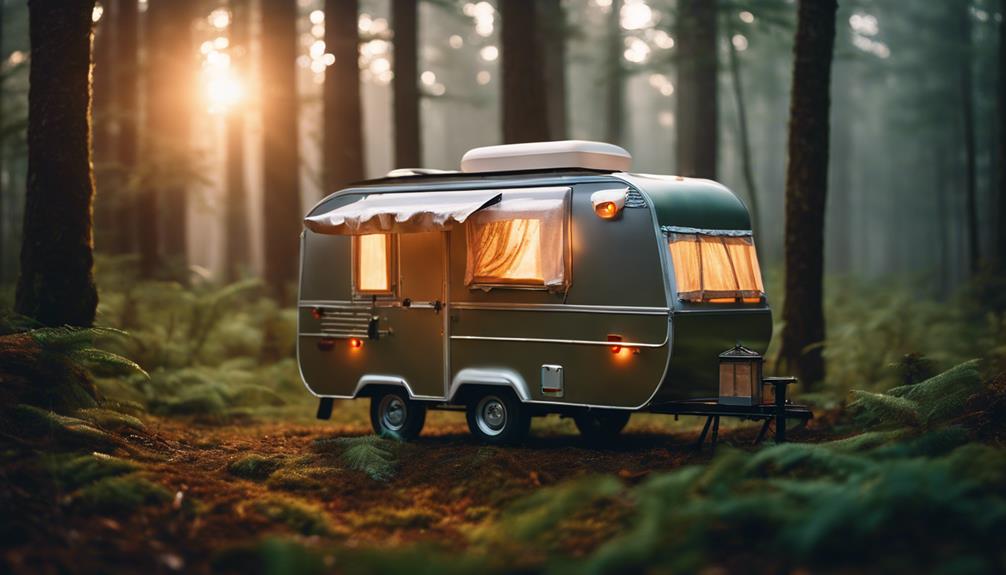
Many campers have found that incorporating community-recommended strategies can greatly reduce condensation in pop-up campers. Proper ventilation is essential, so consider keeping your windows slightly open and using roof vents to enhance airflow. This helps control humidity levels and prevents moisture build-up.
Many seasoned campers swear by insulation products like Pop-Up Gizmos (PUGS). These not only help maintain warmer canvas temperatures but also minimize condensation by reducing the temperature differential between the inside and outside of the camper.
You might also want to invest in moisture-absorbing materials, such as DampRid or electric dehumidifiers. These can effectively manage humidity levels inside your space, keeping it dry and comfortable.
Regular maintenance and leak detection are also important; leaks can exacerbate moisture problems, often more so than condensation itself.
Recommended Products and Equipment
To keep condensation at bay in your pop-up camper, consider investing in specific products and equipment designed to improve insulation and reduce humidity levels. These items can make a significant difference in maintaining a dry and comfortable environment.
- Pop-Up Gizmos: These innovative covers insulate the bunk ends, creating air pockets that trap warmth and minimize condensation.
- DampRid: Place these moisture-absorbing products inside your camper to capture excess humidity, helping to keep the air dry.
- Electric Dehumidifiers: A small electric dehumidifier actively removes moisture from the air, maintaining a consistently dry interior.
Additionally, don't underestimate the power of thermal curtains. They help insulate the interior, reducing heat loss during colder nights and minimizing the temperature difference that contributes to condensation.
Frequently Asked Questions
How to Stop Condensation in Pop-Up Camper?
To stop condensation in your pop-up camper, keep windows slightly open for ventilation, use insulating materials on bunk ends, monitor humidity levels, and store wet gear outside to minimize moisture buildup.
How to Stop Condensation in a Camper Van?
Did you know that up to 80% of moisture in a camper van comes from breathing? To stop condensation, keep windows slightly open, use fans for air circulation, and monitor humidity with moisture-absorbing materials.
How to Keep a Tent Dry From Condensation?
To keep your tent dry from condensation, guarantee proper ventilation by opening windows and vents. Store wet gear outside, choose elevated campsites, and use absorbent materials to manage moisture effectively.
Do Pop up Campers Stay Dry?
Do pop-up campers stay dry? Well, it depends on how you manage humidity. If you don't ventilate properly or check for leaks, you'll likely find moisture accumulating, turning your cozy retreat into a damp disappointment.
What Are Some Tips for Keeping a Pop-Up Camper Dry and Preventing Condensation?
To prevent condensation and keep a pop-up camper dry, make sure to properly ventilate the interior by cracking windows or using roof vents. Additionally, using moisture-absorbing products and dehumidifiers can help control humidity levels. Inspecting and sealing any potential sources of leaks is crucial for effective moisture prevention. Learn how to detect camper leaks to address them promptly.
Conclusion
To sum up, preventing condensation in your pop-up camper is all about smart planning and execution.
Did you know that around 40% of RV owners experience moisture issues at some point?
By implementing effective ventilation, insulation techniques, and regular maintenance, you can stay dry and comfortable on your adventures.
So, take these insights to heart, and enjoy your trips without the worry of dampness ruining your experience.
Happy camping!


